SmartAnt Telecom SAG-1010 802.11bg Wireless Card User Manual User Guide
SmartAnt Telecom Co., Ltd. 802.11bg Wireless Card User Guide
Contents
- 1. User Guide
- 2. User Guide pt 2
User Guide
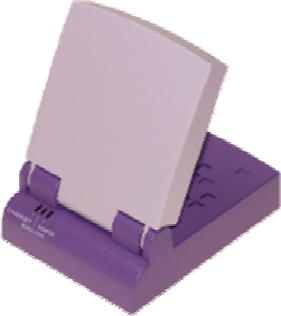
802.11b/g wireless card
SAG-1010
User’s Manual v0.2
SAG-1010

For all the device
(15.21)
Warning: Changes or modifications to this unit not expressly approved by the
party responsible for compliance could void the user authority to operate the
equipment.
15.19 (a)(3)
This device complies with Part 15 of the FCC Rules. Operation is subject to the
following two conditions: (1) this device may not cause harmful interference, and
(2) this device must accept any interference received, including interference that
may cause undesired operation.
The users manual or instruction manual for an intentional or unintentional
radiator shall caution the user that changes or modifications not expressly
approved by the party responsible for compliance could void the user’s authority
to operate the equipment.
CAUTION:
1. To comply with FCC RF exposure compliance requirements, a separation
distance of at least 20 cm must be maintained between the antenna of this
device and all persons.
2. This Transmitter must not be co-located or operating in conjunction with any
other antenna or transmitter.
Table of Content
1. Product Introduction ........................................................................................... 1
1.1
W
ELCOME
......................................................................................................... 1
1.2
P
ACKAGE CONTENTS
......................................................................................... 1
1.3
FEATURES
.......................................................................................................... 2
1.3.1
T
OP VIEW
................................................................................................... 2
1.3.2
BOTTOM VIEW
............................................................................................ 2
1.3.3
REAR VIEW
................................................................................................. 3
1.4
LED INDICATORS
................................................................................................ 3
1.5
RECOMMENDED NETWORK SETTINGS
................................................................. 4
1.5.1
ACCESS POINT MODE
.................................................................................. 4
1.5.2
ETHERNET ADAPTER MODE
........................................................................ 5
2. Hardware Installation.......................................................................................... 7
2.1
SYSTEM REQUIREMENTS
.................................................................................... 7
2.2
DEVICE INSTALLATION
...................................................................................... 7
2.2.1
BEFORE YOU PROCEED
............................................................................... 7
2.2.2
USING DC POWER
........................................................................................ 8
2.2.3
USING USB BUS POWER
............................................................................... 8
2.3
PLACEMENT
....................................................................................................... 9
2.3.1
WALL MOUNTING
....................................................................................... 9
2.3.2
WINDOW MOUNTING
.................................................................................. 9
2.4
OPERATING RANGE
.......................................................................................... 10
2.4.1
RANGE
...................................................................................................... 10
2.4.2
SITE SURVEY
............................................................................................ 10
3. Configuration...................................................................................................... 11
3.1
WEB CONFIGURATION
........................................................................................ 11
3.1.1
ADJUSTING THE TCP/IP SETTING
............................................................. 11
3.1.2
LAUNCHING THE WEB CONFIGURATION
................................................ 13
3.2
CHANGING THE ACCESS POING(AP) CONFIGURATION
................................... 13
3.3
CHANGING THE ADAPTER CONFIGURATION
.................................................. 24
4. Using the Device ................................................................................................. 29
4.1
USING THE DEVICE IN A LOCAL NETWORK
.................................................... 29
4.2
REPLACING THE COMPUTER ETHERNET CABLES
........................................... 29
4.3
REPLACINT CABLE CONNECTIONS OF OTHER DEVICES
................................. 30

1
1. Product Introduction
1.1. Welcome!
Thank you for choosing the SAG-1010 series. The SAG-1010 is a compact easy-to-install Ethernet
adapter. Implementing the IEEE 802.11g standard for wireless LAN (WLAN), the SAG-1010 is
capable of up to 54Mbps data transmission rate using the Direct Sequence Spread Spectrum
(DSSS) and the Orthogonal Frequency Division Multiplexing (OFDM) technologies.
The SAG-1010 supports Infrastructure and Ad-hoc modes giving you flexibility on your existing
or future wireless network configurations.
To provide efficient security to your wireless communication, SAG-1010 comes with a 64-bit/128-
bit Wired Equivalent Privacy (WEP) encryption and Wi-Fi Protected Access (WPA) features.
With these and many more, SAG-1010 is sure to keep you ahead in the world of wireless
computing.
1.2. Package contents
Check the following items in your SAG-1010 package. Contact your retailer if any item is
damaged or missing.
⊙ Range extension WLAN adapter
⊙ Power adapter
⊙ RJ-45 cable
⊙ USB Cable
⊙ Mounting set
⊙ Quick Installation Guide
Unless otherwise specified, the term “device” in this User Guide refers to the SAG-1010.
1.3. Features
The SAG-1010 employs the DSSS and OFDM technologies to transmit and receive signals
through radio waves on the 2.4 GHz band.
Here are other SAG-1010 features:
• Reliable data transfer rates of up to 54Mbps
• Secure data transmission via Wired Equivalent Privacy (WEP) and WiFi Protected Access (WPA)
encryptions
• Operating distance of up to 260ft (80m) indoors and 2000 ft (620m) outdoors
• Equipped with mounting set for window mount and wall installation
• Dual power mode (DC or USB bus-powered)
• Windows
®
2000/XP, Vista compatible
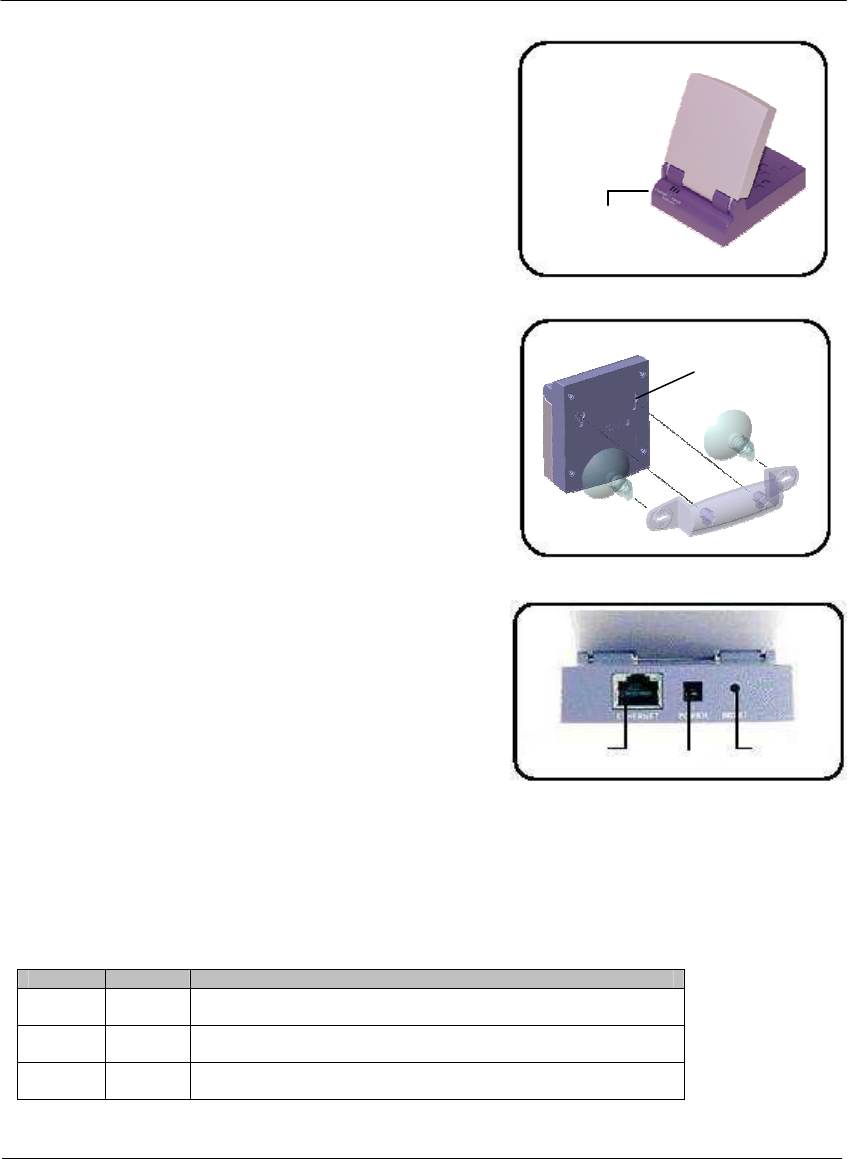
2
1. Product Introduction
1.3.1. Top View
LEDs
The SAG-1010 comes with three LED indicators
(Ethernet, Wireless, and Power).
Air vents.
These vents provide ventilation to the device.
1.3.2. Bottom View
Mounting hook
Use the mounting hook to install the device on
concrete or wooden surfaces using a roundhead screw.
1.3.3. Rear View
Ethernet port
This port connects the supplied RJ-45 plug and cable.
Power socket
This socket connects the power adapter plug.
Reset button
Press this button for more than five seconds to load the
default values. In Ethernet adapter mode, press this
button for less than five seconds to connect to the first
saved wireless connection in the profile table.
1.4. LED indicators
The SAG-1010 comes with a Ethernet, Wireless, and Power LED indicators. Refer to the table
below for LED indications.
LED Status Indication
Ethernet
On
Off The device is connected to an Ethernet network.
The device is off or not connected to an Ethernet network.
Wireless
Off
Blinking
The device is not associated with an AP or other wireless device.
The device is transmitting or receiving data.
Power On
Off The device is on and ready.
The device is off or performing boot sequence.
Ethernet
DC IN socket
Reset button
Status Indicators
Mounting hole

3
1. Product Introduction
1.5. Recommended network settings
The SAG-1010 can be configured as a wireless Ethernet adapter. In Ethernet adapter mode, the
device connects to:
1. A wireless device(s) (Ad-hoc mode), or
2. An access point (Infrastructure network type)
Determine your network settings before installing the SAG-1010. The following network settings
are recommended.
1.5.1. Access Point mode
When in access point (AP) mode the SAG-1010 Pocket Wireless AP connects WLAN-enabled
computers and/or devices to a wired or wireless LAN.
Internet
Hub
Network Printer
Client 1
Client 2
Client 3
Client 4
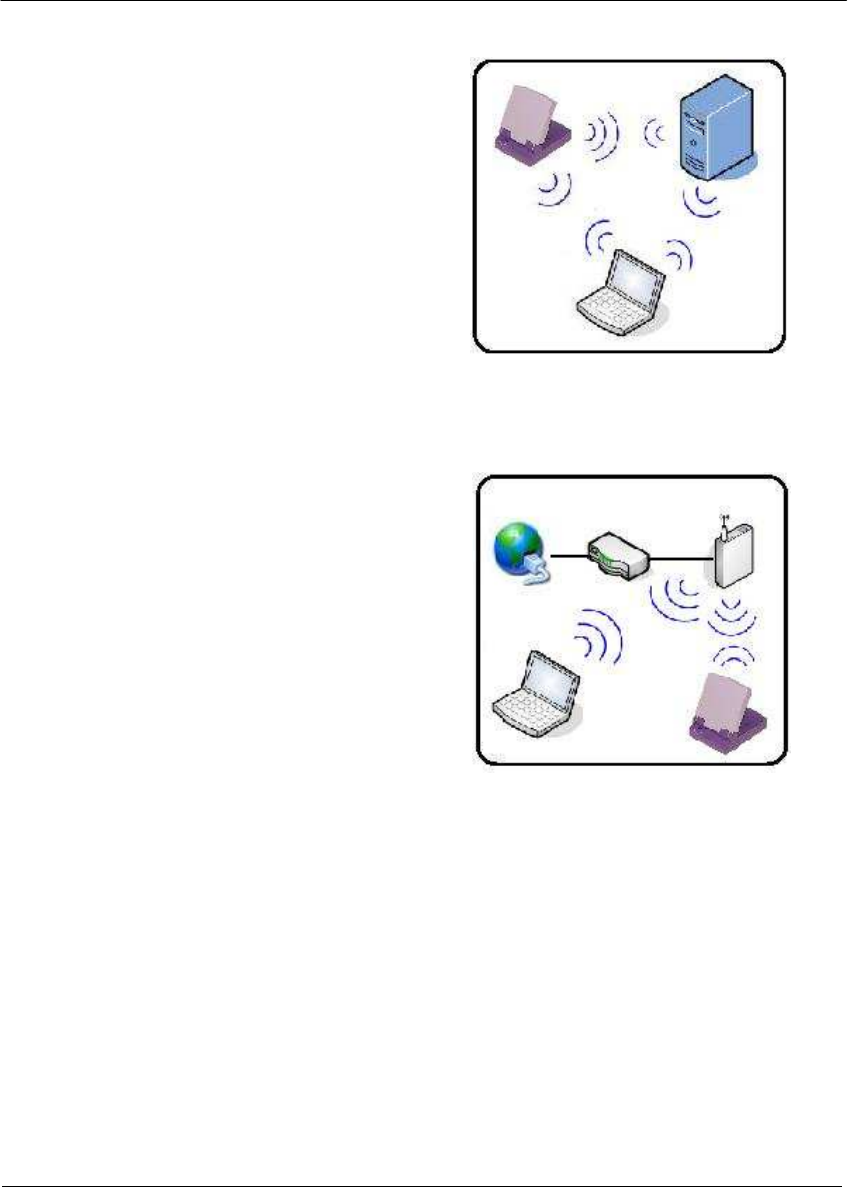
4
1. Product Introduction
1.5.2. Ethernet adapter mode
Ad-hoc network
When in Ad-hoc network, the SAG-1010
connects to another wireless device.
No access point (AP) is present in this
wireless environment.
Infrastructure mode
When in Infrastructure mode, the wireless network is
centered on an access point (AP) that provides a
central link for wireless clients to communicate
with each other or with a wired network. In this
setup, the SAG-1010 connects to an AP using a
single or multiple IP to establish connection to a
wired or wireless LAN.
Station 1
Station
2
Internet
ADSL Modem Access Point
Station 1
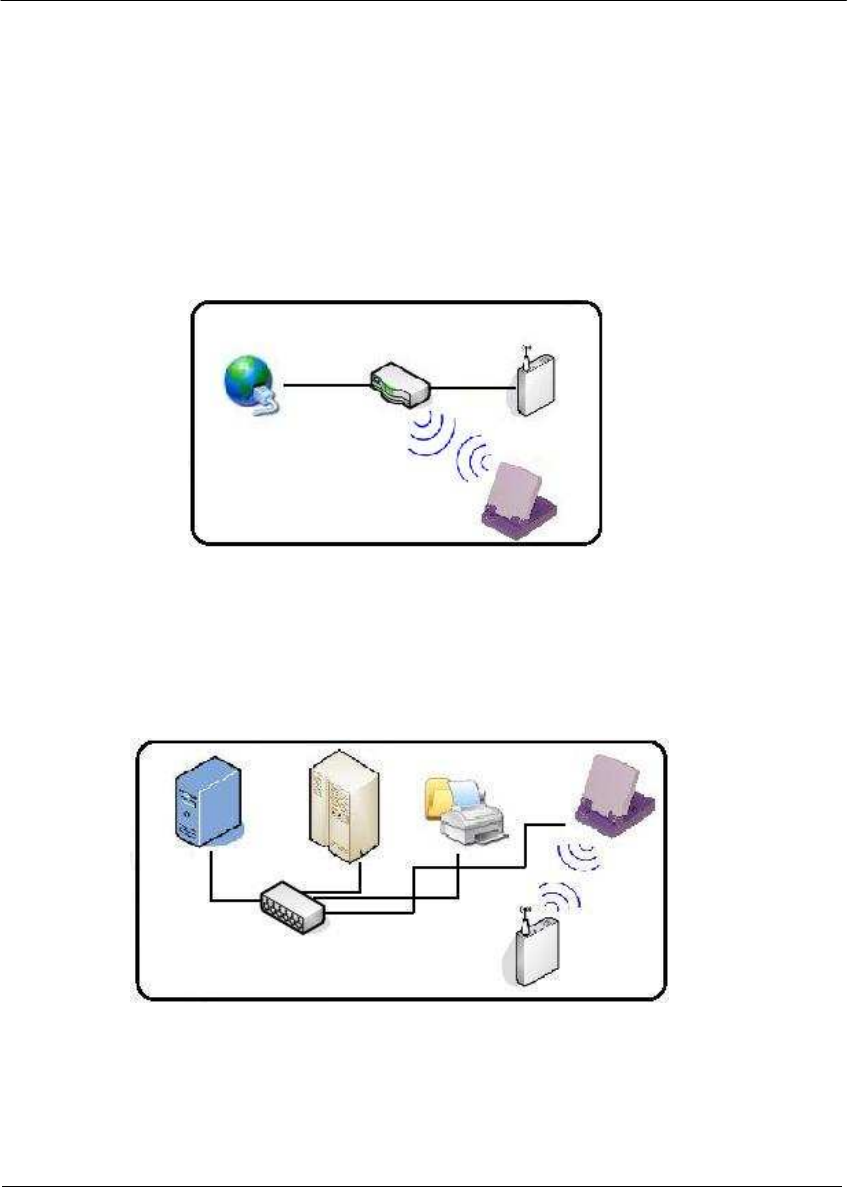
5
1. Product Introduction
Single IP bridge environment
In a single IP bridge environment, the SAG-1010 connects to an access point using a single IP
address.
In this setup, the MAC cloning feature may be enabled to support certain applications and
devices, such as Xbox and PlayStation® game consoles, that use the MAC address to
communicate with other devices. MAC cloning allows the SAG-1010 to communicate with other
devices in a wireless network using the MAC address of the host computer instead of its own.
Multiple IP bridge environment
In a multiple IP bridge environment, the SAG-1010 connects two or more wired devices to a
wireless network from a hub or a switch.
Access Point
Internet
ADSL Modem Access Point

6
2. Hardware istallation
2.1 System requirements
Before installing the SAG-1010, make sure that your system/network meets the following
requirements:
• An Ethernet RJ-45 port (10Base-T/100Base-TX)
• At least one IEEE 802.11b/g device with wireless capability
• An installed TCP/IP and Internet browser
2.2 Device installation
Follow these instructions to install the SAG-1010.
Connect the device to your computer, network hub, switch, or router.
2.2.1 Before you proceed
Take note of the following guidelines before installing the SAG-1010.
• The length of the Ethernet cable that connects the device to the network (hub, ADSL/cable
modem, router, wall patch) must not exceed 100 meters.
• Place the device on a flat, stable surface as far from the ground as possible.
• Keep the device clear from metal obstructions and away from direct sunlight.
• Keep the device away from transformers, heavy-duty motors, fluorescent lights, microwave
ovens, refrigerators, and other industrial equipment to prevent signal loss.
• Install the device in a central area to provide ideal coverage for all wireless mobile devices.
• Install the device at least 20cm from a person to insure that the product is operated in
accordance with the RF Guidelines for Human Exposure adopted by the Federal
Communications Commission.
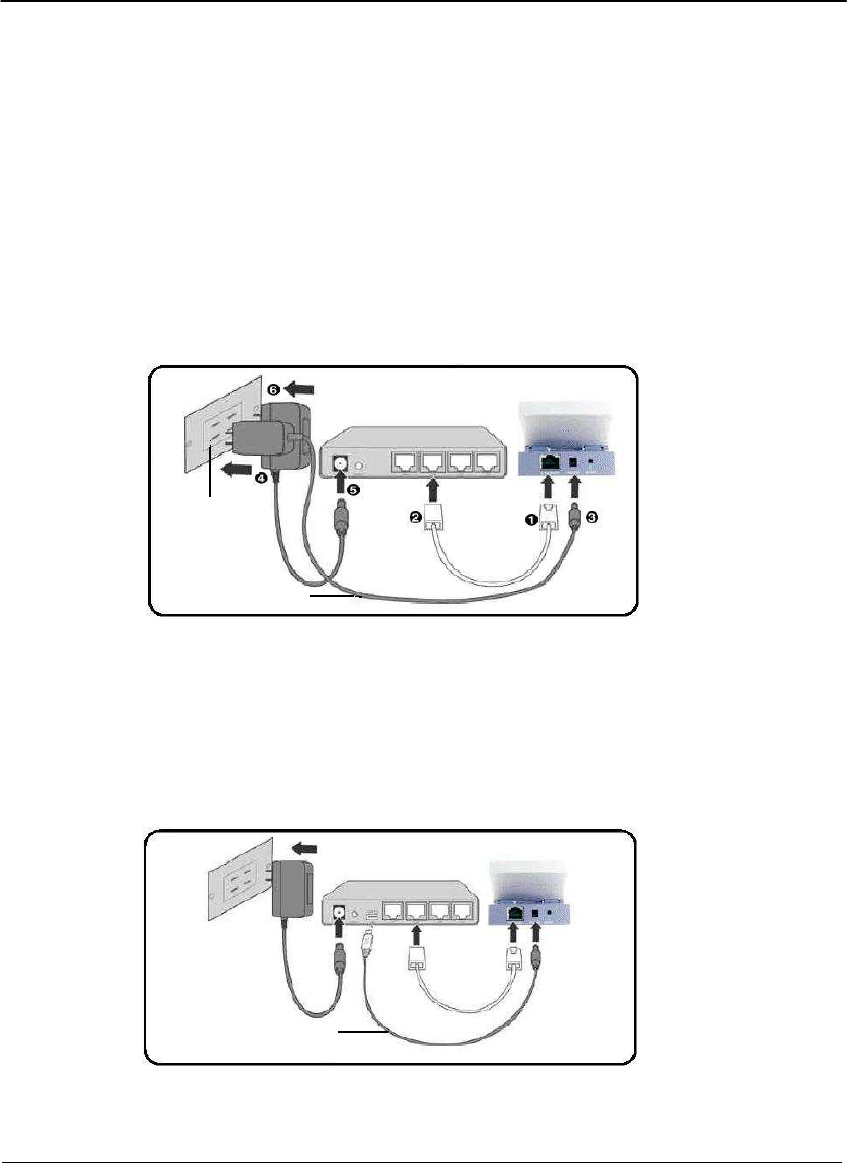
7
2. Hardware istallation
2.2.2 Using DC power
1. Insert one end of the supplied RJ-45 cable to the SAG-1010 Ethernet port.
2. Insert the other end of the RJ-45 cable to a network hub, switch, router, or wall patch Ethernet
port.
3. Connect the power adapter plug to the SAG-1010 Power socket.
4. Connect the SAG-1010 power adapter to a wall socket.
5. Connect the network hub, switch, or router power adapter plug to the Power socket of the device.
6. Connect the network hub, switch, or router power adapter to a wall socket.
2.2.3 Using USB bus power
Replace the AC-DC power cable with a USB power cable and insert into an available USB port
on any device (computer, notebook, network hub, switch, or router) and turn ON that device.
Wall socket
Network Device
AC
-
DC power cable
Network Device
with USB
USB power cable

8
2. Hardware istallation
2.3 Placement
2.3.1 Wall mounting
Aside from desktop placement, you can install the
SAG-1010 vertically on a wall using the mounting
hook at the bottom side of the device.
To mount the device on a wall:
1. Tighten a screw on the wall until only 1/4 inch is
showing.
2. Latch the mounting hook on the screw.
2.3.2 Window mounting
Using the window mount sets, SAG-1010 can be installed on flat window class, and receive
wireless signals from either side of the window.
To mount the device on a window class:
1. Compose window mount set. Reverse the suck discs, if the signal is from the other side of the
window.
2. Compose the window mount set on the middle of the bottom of the device.
3. Press both suck discs onto the window class. Make sure the device does not fall before leave
you hands.
Adjust the screw if you cannot latch the device or if the device is too loose.
Mounting hook

9
2. Hardware istallation
2.4 Operating range
2.4.1 Range
The SAG-1010 range is dependent on the operating environment. Every home or office layout
varies in obstacles, barriers, or wall types which may reflect or absorb radio signals. For example,
two 802.11b devices in an open space may achieve an operating distance of up to 1000 meters,
(3280 feet) while the same devices may only achieve up to 300 meters (984 feet) of range when
used indoors.
The device automatically adjusts the data rate to maintain an operational wireless connection. A
wireless device that is close to an AP may operate at higher speeds than a device far from the AP.
You can configure the data rates that a device uses. If you limit the range of data rates available
to an AP, you may reduce the effective range of the wireless LAN coverage.
2.4.2 Site Survey
A site survey (utility provided with the SAG-1010) analyzes the installation environment and
provides users with recommendations for equipment and its placement. The optimum placement
differ depending on the device design and specifications.

10
3. Configuration
3.1. Web Configuration
The Web Configuration utility allows you to configure the SAG-1010 using a web browser on
your computer. The following sections provide information on how to launch and use this utility.
3.3.1 Adjusting the TCP/IP settings
By default, the IP address of the SAG-1010 is 192.168.1.1, and the Subnet Mask is
255.255.255.0. To access the configuration utility, assign a different IP address to the network
adapter where the SAG-1010 is connected.
To adjust the TCP/IP settings of the network adapter:
1. Right-click the Network Connections icon in the Windows® desktop, then select Properties from
the pop-up menu. The Network and Dial-up Connections window appears.
2. Right-click the network adapter used by the the SAG-1010, then select Properties from the pop-up
menu. The Local Area Connection Properties window appears.
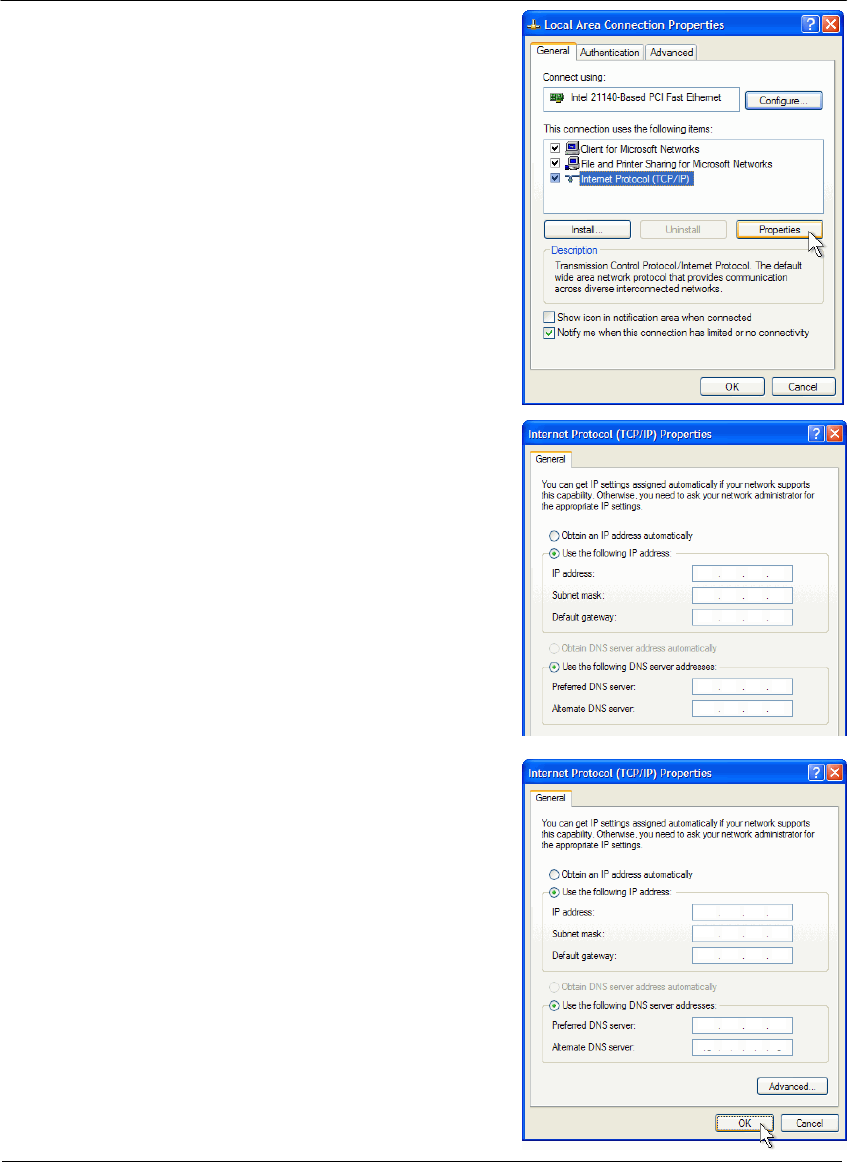
11
3. Configuration
3. Double-click the Internet Protocol (TCP/IP) item to
display the Internet Protocol (TCP/IP) Properties
window.
4. Check the Use the following IP address option, then
enter the IP address for the network adapter. The IP
address must be 192.168.1.X.
(X can be any number between 2 and 254 that is not
used by another device.)
5. Set the Subnet Mask to 255.255.255.0. Click OK
when finished.
Changing the TCP/IP settings may require system restart.
Switch on the SAG-1010 immediately after rebooting.
192
1
68
1
10
192
1
68
1
10
2
55
255
255
0
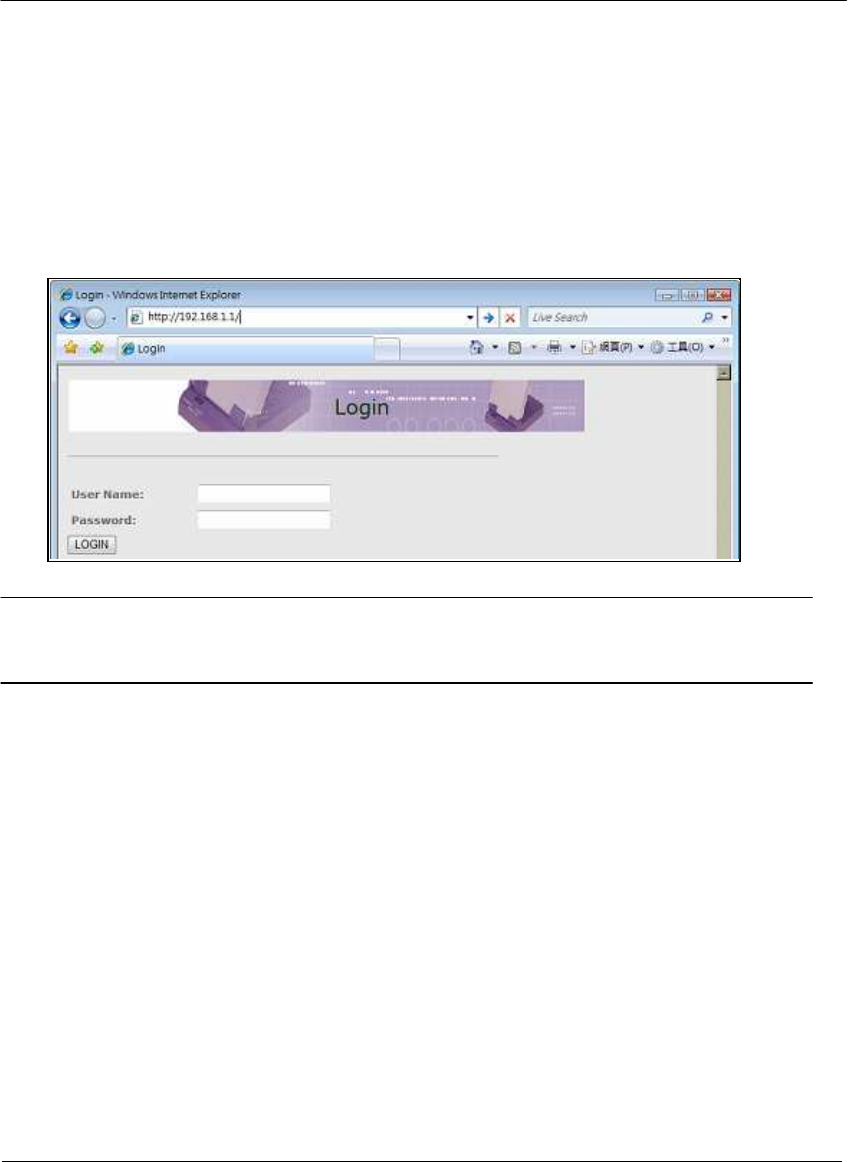
12
3. Configuration
3.3.2 Launching the Web Configuration
Using an Internet browser
To launch the Web Configuration utility using an Internet web browser:
1. Open a web browser.
2. Disable your proxy settings, if any.
3. Type http://192.168.1.1 on the address bar of the browser, and then press <Enter>.
4. Log on to the configuration window using the user name (admin) and password (admin),
then click OK.
This option requires you to change the IP address of the LAN adapter where the SAG-
1010 is connected. Make sure the IP address of the SAG-1010 and your computer is on
the same subnet.
3.3.3 Changing the Access Point (AP) Configuration
Simple Setup Page
The Simple Setup page displays the default AP settings of the SAG-1010.
Use this page to set the AP channel, operation mode, and security.
Clicking the select button displays available options for that field. If you wish to load the default
settings, press the device reset button for more than five seconds, and then refresh your browser
to display the default values.
SSID (Service Set Identifier). This field displays the SSID of the device.
Enabling the Response to Broadcast SSID requests option allows the device to broadcast its
SSID in a wireless network. This allows other wireless devices to scan and establish
communication with the device.
Un-checking this option hides the SSID to prevent other wireless devices from recognizing and
connecting to the device.